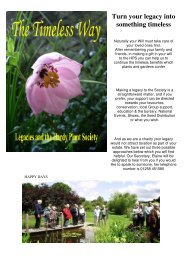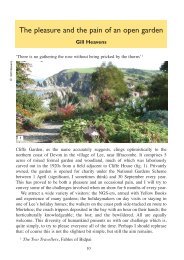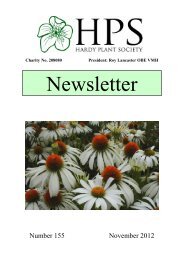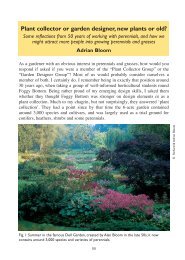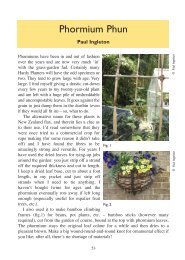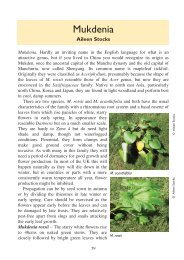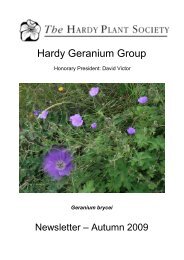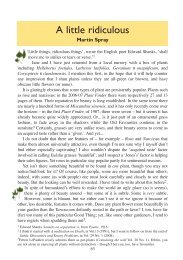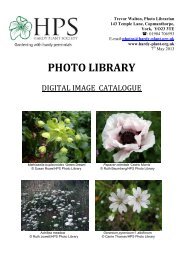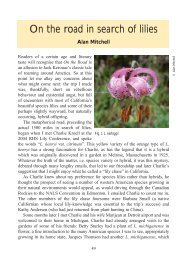Aster novi-belgii - Hardy Plant Society
Aster novi-belgii - Hardy Plant Society
Aster novi-belgii - Hardy Plant Society
You also want an ePaper? Increase the reach of your titles
YUMPU automatically turns print PDFs into web optimized ePapers that Google loves.
that the public showed much interest in shortgrowing<br />
asters. ‘Lady in Blue’ (fig. 13) was raised by<br />
Perry’s and introduced by Carlile’s in 1955. In the<br />
1960s the ever popular and showy, pale pink<br />
‘Chatterbox’ (fig. 14) was introduced by Bakers, and<br />
from Blooms Nurseries came sturdy 40cm ‘Jenny’<br />
with large purple-red flowers and its twin, ‘Royal<br />
Ruby’. Records indicate ‘Jenny’ as a different plant<br />
raised by Mr. Harrison in 1926. In spite of the<br />
confusion, the modern ‘Jenny’ became one of the<br />
best-selling asters of all time. Dutch and German<br />
plant breeders came to the fore with many excellent<br />
dwarf cultivars: ‘Professor Anton Kippenberg’ has<br />
bright blue flowers, ‘Kassel’ bright, reddish-purple<br />
and ‘Rosenwichel’ pink flowers on low spreading<br />
clumps.<br />
Few <strong>novi</strong>-<strong>belgii</strong> asters from the 1920s and 1930s<br />
grow to the useful height of around 60cm. The dwarf<br />
cultivars led slowly to the introduction of a small<br />
range of these intermediate-sized plants. William<br />
Woods and Sons of Taplow offered ‘Little Red Boy’<br />
in 1946. It was bettered in 1950 by the Gayborder<br />
Nurseries introduction of ‘Winston S. Churchill’, a<br />
very bushy plant, about 70cm, with masses of bright,<br />
purple-red flowers, an instant hit with gardeners, in<br />
spite of being more prone to mildew attack than most.<br />
‘Chequers’ (fig. 15) was raised by Gayborder Nurseries<br />
in 1953 and has really rich, violet-purple flowers.<br />
Percy Picton raised the very last ‘Ballard’ aster,<br />
from the original strain, in 1972. This was ‘Sarah<br />
Ballard’, named after Ernest Ballard’s granddaughter.<br />
The flowers are large, full rayed, lilac purple, on plants<br />
growing to about 100cm. So far the only <strong>novi</strong>-<strong>belgii</strong><br />
asters I have seen fit to add were ‘Ralph Picton’<br />
(fig. 16) in 1991 and in 1994 ‘Marjory Ballard’, named<br />
after a Colwall lady who was a very keen gardener and<br />
the wife of one of Ernest Ballard’s nephews.<br />
The popularity of the <strong>novi</strong>-<strong>belgii</strong> group spanned 70<br />
years. Before the war, borders devoted to them were<br />
a common feature in gardens throughout the UK. It<br />
21<br />
Fig. 9 ‘Fellowship’<br />
Fig. 10 ‘Sandford’s White Swan’<br />
Fig. 11 ‘Coombe Rosemary’<br />
Fig. 12 ‘Gurney Slade’<br />
© Paul Picton<br />
© Paul Picton<br />
© Paul Picton<br />
© Paul Picton



